Can braids lead to hair and scalp issues? Although braids are a protective hairstyle and can be a great way to protect and grow your hair, they can also cause specific issues. What are these issues? Well, dandruff, for starters.
But how do braids cause dandruff?
Braids, when kept for too long, can cause various problems. When braids are kept for 8-10 weeks, they can cause your scalp to collect a lot of debris, dust, and dead skin cells. This leads to dandruff formation.
So, what can you do to remove dandruff on your hair and scalp? Mainly when braids cause it? Stick with us because we’ll tell you all you need to know about tackling it.
Do Braids Keep Hair Healthy
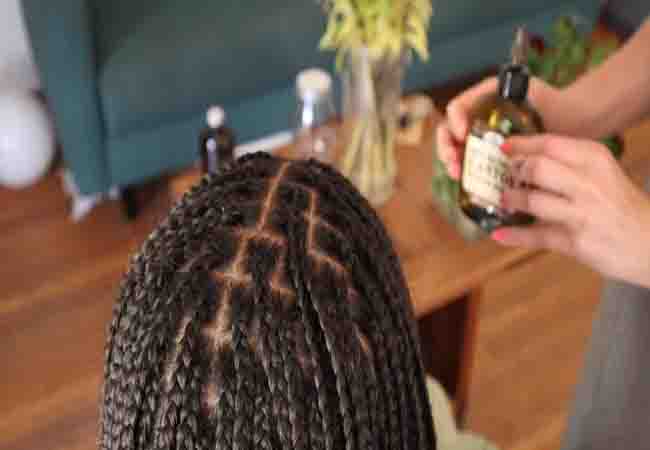
If you’re wondering how to keep your hair and scalp healthy while keeping your braids intact, read through the texts below to have all your questions answered:
1. Braids and Your Scalp
If braids aren’t done or maintained correctly, they can become tedious to manage. A dry scalp is one of the problems that can happen due to improper installation or management of braids.
2. Should I Oil My Scalp Before Braids
Yes, oiling your hair before getting braids installed helps lock moisture in your hair and scalp. Braids can cause your hair and scalp to dry. Oiling them before getting braids helps prevent this issue and makes your hair look better.
3. Should You Oil Your Scalp Every Day with Braids
One way to maintain braids properly is to moisturize them regularly. And this can be done by oiling your braids. If you can’t do that, oil your braids at least 2-3 times per week.
4. What Are the Side Effects of Braiding Hair

Problems that can occur from having braids include, but are not limited to, the following:
- Braids can strain your hair and damage hair follicles if they are installed too tightly.
- They can tug and pull on your hair, causing hair breakage.
- Tight braids can lead to traction alopecia, a condition that causes permanent baldness.
- Keeping braids for too long can cause dirt, debris, and dandruff to accumulate on your scalp.
5. What Happens When You Wear Braids for Too Long

Wearing braids for too long isn’t suggested by experts as it can cause irreversible damage to the hair and scalp. The constant tugging and pulling that occurs from braids can result in a receding hairline and hair breakage, leading to permanent baldness.
6. How Do You Keep Your Scalp Healthy with Braids
To keep your hair and scalp healthy while you have braids, maintain the following:
- Don’t tie your braids too tightly.
- Moisturize your hair and scalp often.
- Wash and shampoo your braids once a week.
- Don’t keep your braids on for longer than 8 weeks.
- When going to sleep, wear a satin scarf or bonnet, or sleep on a satin pillowcase.
Do Braids Make Dandruff Worse
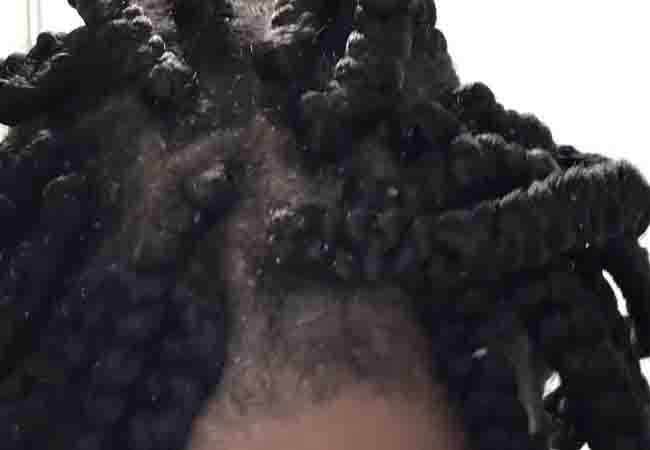
The questions about dandruff and its impact on hair and scalp health are never-ending. If you have braids and are noticing dandruff on your hair and scalp, you might be wondering if your braids are the cause.
Read on below to know the answers to your question:
- Dandruff can be a nightmare without you even realizing it. It becomes extremely tough to maintain braids when there’s dandruff on the hair and scalp.
- When you refrain from washing your hair with braids, it becomes hard to remove dandruff from oily hair, leading to hair breakage. Dandruff is a result of an unhealthy scalp, and braids aren’t the only reason behind it. Mainly, the dead skin cells of your scalp flake off and cause dandruff formation.
- Heavy dandruff can cause people with braids to have inflammation on their scalp. Dandruff is among the most common hair problems that not only cause constant itching but also prevent you from wearing your favorite dark clothes.
- A dehydrated scalp is dandruff’s best friend. When your scalp turns dry due to hair wax, it becomes flaky and causes hair shedding. It is a common problem that can occur due to the usage of hair products like wax and gel.
- Also, there’s a difference between dandruff and a dry scalp. Dandruff sticks to your scalp and the dry scalp flakes can stick to your hairbrush more than the powdery white flakes.
- A heavy amount of dandruff usually indicates a lack of moisture and oils on the scalp and an excessive amount of dead skin and hair products on the scalp, which leads to itchiness and accumulation on the scalp.
- Dandruff, fungal infection, psoriasis, or eczema can create a sense of burning pain on the scalp.
- Apart from that, psoriasis also looks like dandruff but is thicker and red. The psoriasis coating on your scalp might be extra skin cells flaking off, which can become a reason behind hair fall.
- Psoriasis can be treated the same way dandruff is treated, says Esta Kronberg, a dermatologist based in Houston, Texas.
What Causes Dandruff in Braids?
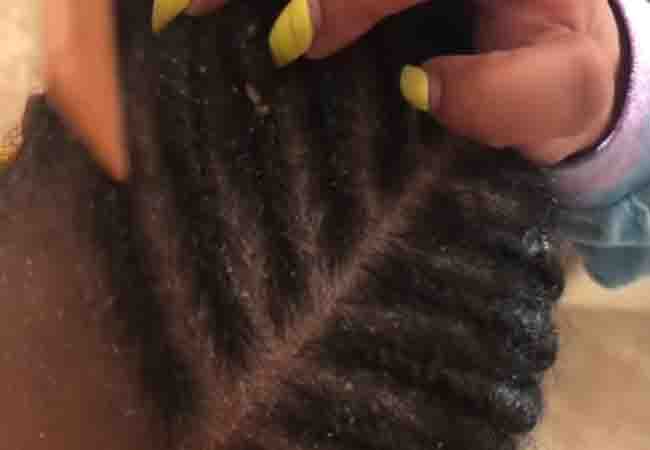
Various factors can play a role in dandruff forming on your scalp. They can form due to, but are not limited to, the following:
a. Fungus
Dandruff is caused by a fungus known as Malassezia. It grows in damp environments. This is why too much sweating in the summer and monsoon can make dandruff a big problem.
b. Skin Conditions
Dandruff is created by seborrheic dermatitis. It’s a condition that turns your scalp red, oily, and scaly. Eczema or dandruff can also cause inflammation of the scalp. When the scalp shows signs of inflammation, a lot of yeast is produced, which leads to dandruff.
c. Unclean Scalp and Hair
A build-up of oils, dirt, debris, and hair products can lead to dandruff formation as well. The wax and sebum oil in your hair mixes with the sweat on your scalp at night, making your scalp flaky and causing dandruff.
This is the result of excessive oil build-up on the scalp. The extra oil leads to a build-up of skin cells, which turns into flakes.
d. Hair Products
Silicon is a common product in a lot of shampoos, conditioners, and styling products. Try avoiding products with silicon in them, as it can also cause dandruff production.
Also, know that Not shampooing enough or too much shampooing can also lead to dandruff formation.
e. Health Condition
An imbalance in hormones can also be responsible for the production of dandruff on the scalp and hair.
f. Diet
Malnutrition, fried food, fizzy drinks, fat, sugar, salt, chocolates, seafood, peanuts, and lastly, dairy products can also cause dandruff.
How Do I Prevent Dandruff When I Have Braids
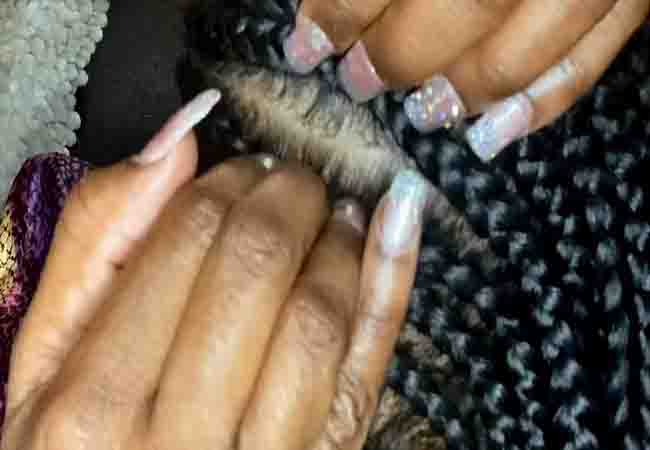
When it comes to preventing dandruff production without losing your braids, the importance of the following advice is impeccable:
- Shampoo with Anti-Bacterial Ingredients: In case of light dandruff formation, the best treatment is to apply shampoo with anti-bacterial, pyrithione zinc, and spearmint ingredients. A homemade remedy for dandruff is fenugreek seeds, which have anti-bacterial and anti-fungal properties that work really well in removing flakes.
- Fenugreek Seed Remedy for Dandruff: Tea tree oil has strong anti-microbial and anti-inflammatory properties that work against dandruff formation.
- Tea Tree Oil Treatment: Lavender oil helps reduce dryness, flaky dandruff, and itchiness. Apart from that, almond oil, argan oil, and avocado oil also help fight dandruff.
- Baking Soda Scalp Revitalization: Baking soda reduces excessive oil from the scalp and revitalizes the scalp. It also helps reduce excessive fungal infections that can cause dandruff.
- Lemon Juice Citric Acid Treatment: Lemon juice is a really good remedy that is proven to remove dandruff naturally. Since it’s full of citric acid, it can fight against dandruff starting from the hair follicles. Its antimicrobial properties also help remove dandruff-causing fungi.
- Neem for Scalp Care: Neem is another natural product that works extremely well when it comes to caring for the scalp and hair. It has antibacterial properties that work as a treatment for a dirty scalp with dandruff.
- Apple Cider Vinegar pH Balancing Treatment: With its antifungal and antibacterial properties, apple cider vinegar works surprisingly well in preserving the health of your scalp. Vinegar removes all kinds of dandruff-causing fungi and effectively mitigates the issues related to it.
- Apart from all of these, a pH imbalance can also be the main reason behind dandruff sometimes.
How Do You Wash Dandruff with Braids
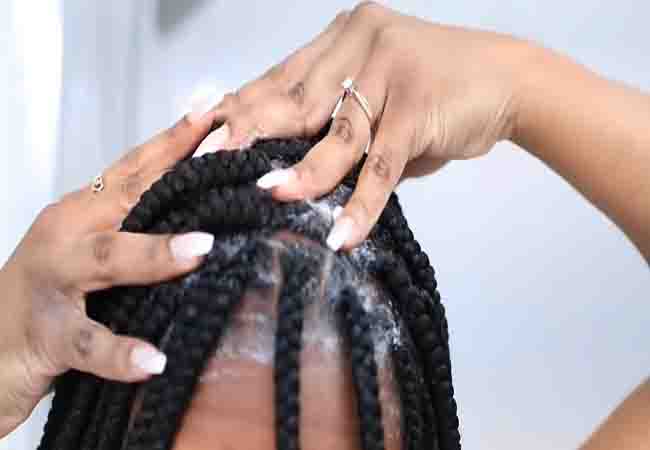
If you notice dandruff on your braids and are looking to eliminate it effectively, do the following:
- Wash your braids a few times a week.
- Properly shampoo your hair and scalp.
- Dry out braids as much as you can.
- Peppermint oil, tea tree oil, and jojoba oil work wonders against dandruff, so apply them to your hair and scalp.
- Undo your braids every few weeks.
- Get nutrient-rich foods.
FAQs
No, but at the same time, dandruff is harmless and not contagious. But it is a sign of an unclean scalp.
When proper maintenance is ensured, braids should be kept for at most 8 weeks. Otherwise, they can lead to too much dirt and debris accumulating on your scalp, which can then result in dandruff formation.
All braids put a strain on your hair and scalp. But you can go for the ones that cause the least amount of strain, like braided ponytails, crochet locks, and knotless braids that don’t require much tugging and are easy to clean. This way, you can mitigate dandruff production on your scalp.
Sleeping with your braids on can make your hair frizzy, brittle, susceptible to breakage, and accumulating lint. Avoid it if you can, as this, too, can lead to dandruff formation as it ruins the health of your scalp.
Coconut oil, castor oil, and jojoba oil all work really well when it comes to combating the itchiness of the scalp caused by dandruff.
Braids have a direct impact on hair health. Braids that are too tight can cause hair breakage and even permanent baldness, and these can hinder hair growth and lead to dandruff formation as a result of unclean hair and scalp.
Braids can cause your scalp and hair to become dry. To avoid that, try moisturizing your braids and scalp as often as possible and no less than twice a week. As moisturizing can prevent flakiness and dandruff.
Scalp peeling in chunks can be caused by various reasons such as dry scalp, seborrheic dermatitis, or other skin conditions.
To wash dandruff out of your hair with braids, use a gentle sulfate-free shampoo or an anti-dandruff shampoo specifically designed for braided hair. Avoid scratching the scalp and rinse thoroughly to remove all product residue.
Braids themselves do not cause dandruff, but improper care and buildup of products on the scalp can contribute to dandruff. It’s important to maintain proper scalp hygiene and avoid heavy products.
It’s recommended to oil your scalp with braids every 1-2 weeks, using a lightweight oil like jojoba or tea tree oil. Avoid heavy oils that can cause buildup on the scalp.
A protective hairstyle that minimizes tension on the scalp, such as loose braids or twists, can be beneficial for dandruff-prone hair. Avoid tight braids or hairstyles that pull on the scalp.
Braids can cause buildup if proper care is not taken. It’s important to cleanse the scalp regularly, avoid heavy products, and rinse thoroughly to prevent buildup.
Braids can cause damage to the scalp if they are too tight, causing tension, traction, and even hair loss. It’s important to avoid tight braids and give the scalp breaks in between protective styles.
Braids can cause damage such as hair breakage, thinning, and traction alopecia if worn for long periods of time or if not properly cared for. It’s important to practice proper hair care and avoid excessive tension on the scalp.
To prevent dandruff with braids, maintain good scalp hygiene by cleansing regularly, avoiding heavy products, and keeping the scalp moisturized with lightweight oils or moisturizers.
Dandruff after braiding may be caused by a combination of factors including dry scalp, product buildup, and lack of proper scalp hygiene. Proper cleansing, moisturizing, and avoiding heavy products can help prevent dandruff.
Itchiness after braiding may be due to various factors including tension on the scalp, dryness, or an allergic reaction. Avoid scratching and consult a dermatologist for proper diagnosis and treatment.
To treat the scalp after braids, gently cleanse with a mild shampoo or diluted apple cider vinegar rinse to remove buildup, moisturize with a lightweight oil or moisturizer, and avoid scratching or excessive manipulation.
Dandruff is characterized by flakes on the scalp that are oily and yellowish, while dry scalp is characterized by small, dry flakes. Proper diagnosis by a dermatologist can help determine the difference.
Some individuals may have an allergic reaction to braiding hair, which can cause itching, redness, and inflammation on the scalp. Discontinue use and consult a dermatologist if you suspect an allergic reaction.
Braids typically loosen up naturally over time, usually within a week or two, depending on the tightness of the braids and the hair type. Avoid excessive manipulation to prevent damage.
Braids can potentially cause dryness on the scalp if not properly moisturized and maintained. Regular scalp cleansing, moisturizing with lightweight oils, and avoiding heavy products can help prevent dryness.
To clean your scalp with braids, dilute a gentle shampoo with water and apply it to the scalp, massaging gently with your fingertips, then rinse thoroughly. Avoid excessive manipulation or scratching.
To fix dry scalp with braids, moisturize regularly with lightweight oils or moisturizers, avoid heavy products that can cause buildup, and maintain proper scalp hygiene by cleansing regularly.
Itchiness after getting braids may be due to various factors such as tension on the scalp, dryness, or an allergic reaction. Proper scalp hygiene, moisturizing, and avoiding heavy products can help alleviate itchiness.
Braids, if not properly cared for, can potentially be unhealthy for hair as they can cause tension, traction, and damage to the scalp and hair shaft. It’s important to practice proper hair care and avoid tight or prolonged wearing of braids.
It’s generally better to take out braids when they are dry to avoid breakage and damage to the hair. Wet hair is more prone to breakage and can be weaker when manipulated.
The frequency of washing braids depends on various factors such as scalp condition, hair type, and lifestyle. However, it’s generally recommended to cleanse the scalp and hair every 1-2 weeks to remove buildup and maintain proper scalp health.
To get rid of dandruff with braids, dilute an anti-dandruff shampoo with water and apply it to the scalp, gently massaging with your fingertips, then rinse thoroughly. Avoid scratching or excessive manipulation of the braids.
To clarify the scalp after braids, use a clarifying shampoo or a diluted apple cider vinegar rinse to remove buildup and restore the scalp’s natural pH balance. Rinse thoroughly and follow up with moisturizing the scalp and hair.
To deep clean braids, dilute a gentle shampoo with water and apply it to the scalp, gently massaging with your fingertips to remove buildup. Rinse thoroughly and follow up with moisturizing the scalp and hair.
The best time to take out braids is when they start to feel loose or after wearing them for a recommended duration (usually 6-8 weeks). Avoid forcefully pulling out the braids to prevent damage to the hair.
To wash braids without ruining them, dilute a gentle shampoo with water and apply it to the scalp, gently massaging with your fingertips, then rinse thoroughly. Avoid rough handling or excessive manipulation of the braids.
Dry shampoo can be used with braids to absorb excess oil and refresh the scalp, but it’s important to use it sparingly and follow the instructions on the dry shampoo bottle to avoid buildup.
It’s generally not possible to wash dandruff out of braids completely, as the flakes may be trapped in the braids. However, regular scalp cleansing, moisturizing, and avoiding heavy products can help prevent dandruff buildup.
Conclusion
Braids can be a great protective hairstyle that also helps you stand out. But they can be problematic as well, as you might have learned by reading this far. We hope you got your answers as to why do braids cause dandruff.
If you have read this far along, we sincerely hope that you now know how to take care of your braids, especially with dandruff, and that you’ll no longer suffer from this harmless but embarrassing condition.

